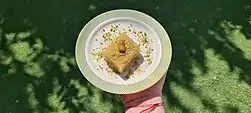 Basbousa topped with walnuts | |
| Alternative names | Harisa |
|---|---|
| Type | Dessert |
| Region or state | Egypt |
| Serving temperature | Cold or warm |
| Main ingredients | Semolina or farina, syrup |
Basbousa (Egyptian Arabic: بسبوسه, romanized: basbūsah) is a sweet, syrup-soaked semolina cake that originated in Egypt.[1][2] The semolina batter is baked in a sheet pan,[3] then sweetened with orange flower water, rose water or simple syrup, and typically cut into diamond (lozenge) shapes or squares. The dish has also spread within most areas of the former Ottoman Empire,[4] and is generally featured in Middle Eastern cuisines, Maghrebi cuisine, Greek cuisine, Azerbaijani cuisine, Ethiopian cuisine, and many others.
Names

It is found in the cuisines of the Middle East, the Balkans and the North Africa under a variety of names.[5]
- Arabic: هريسة harīsa (meaning mashed or crushed), نمورة nammoura, بسبوسة basbūsah
- Hebrew: בסבוסה, romanized: basbūsah
- Armenian: Շամալի, romanized: shamali
- Greek: ραβανί (ravani), ρεβανί (revani), σάμαλι (samali)
- Albanian: revani
- Turkish: revani
- Macedonian and Serbian: раванија, romanized: ravanija
- Bulgarian: реване, romanized: revane
- Somali: basbuusa
- Persian: روغنی
Basbousa is the most common name for this dessert in the Middle East but it may be named differently depending on the region; it is often called "hareesa" in the Levant. Note that "harissa" in North Africa is a spicy red sauce. It is a popular dessert offered in many sweets bakeries in the Middle East and especially popular in Ramadan.

Variations
Pastūsha (sometimes stylized as pastūçha) is a variant of basbousa that originated in Kuwait in the 2010s.[6] Like basbousa, it is made from semolina soaked in sweet syrup. It is characterized by the addition of finely ground pistachios and orange flower water.
Basbousa bil ashta: a Levantine variation of basbousa filled with ashta cream in the middle.
Vegan Basbousa: Basbusa is also available in vegan form using apple sauce to bind the base mix together instead of dairy and eggs.
Basbousa eem Tapuzim: Israeli variation from the coastal region, it is flavored with orange juice, giving it a sweeter and more aromatic flavour.
Basbousa bil Tamr: Libyan variant of basbousa where date spread is being added between two layers of the basbousa.
Basbousa eem Tmarim: Israeli variant of basbousa with dates, unlike the Libyan variant, the dates are being cooked in ghee then added to the mix in addition to cinnamon and cardamom to flavor, giving it a black color in the process. It is served along with tea after the fasting of Yom Kippur is over.
Qizha: Palestinian variant of basbousa with nigella seeds paste called Qizha.
Hilbeh: Palestinian variant of basbousa flavoured with fenugreek seeds.
See also
References
- ↑ The search for the perfect, aunthenic Egyptian-style basbousa,
It originated in Egypt, but is also popular throughout the Middle East and the Mediterranean under different names and variations like: Nammoura, Harissa and Revani
- ↑ "Basbousa (Egyptian Semolina Cake)", isacpittsburgh.org
- ↑ "Arabic Dessert". Archived from the original on 2015-02-08. Retrieved 2015-01-14.
- ↑ Marks, Gil (17 November 2010). Encyclopedia of Jewish Food. HMH. ISBN 978-0-544-18631-6 – via Google Books.
- ↑ Abitbol, Vera (2019-09-25). "Syria: Basbousa". 196 flavors. Retrieved 2020-10-04.
- ↑ "Aunt Zaneb's Semolina Cake Recipe". Easy Recipes. 2021-10-09. Archived from the original on 2022-02-28. Retrieved 2022-02-28.
Works cited
- Davidson, Alan (2014). Oxford companion to food. [S.l.]: Oxford University Press. ISBN 978-0199677337.
